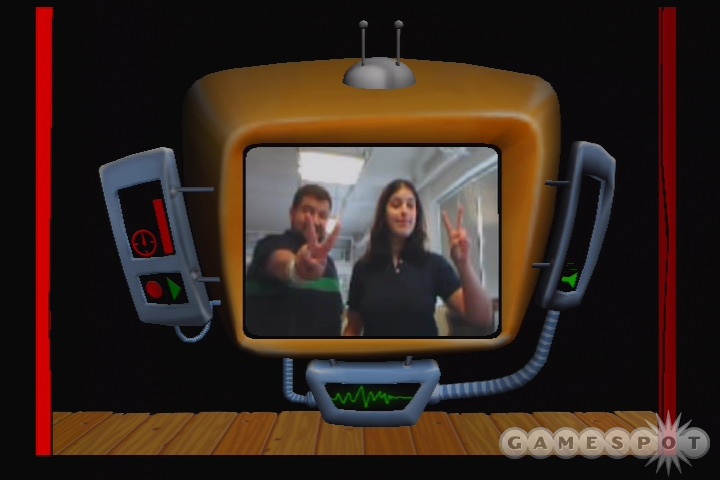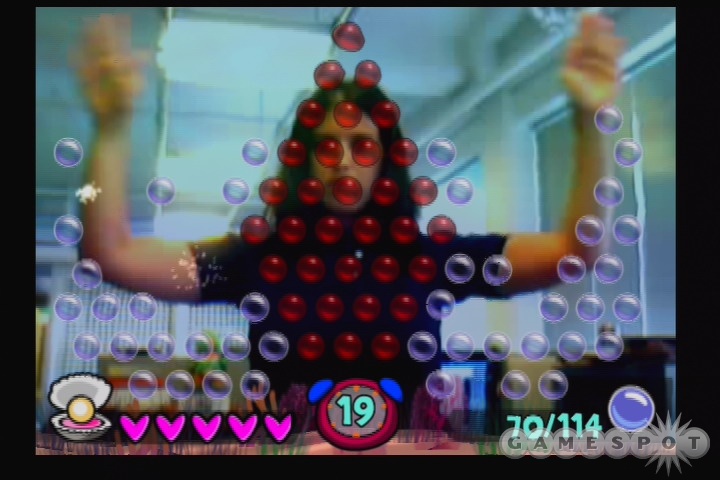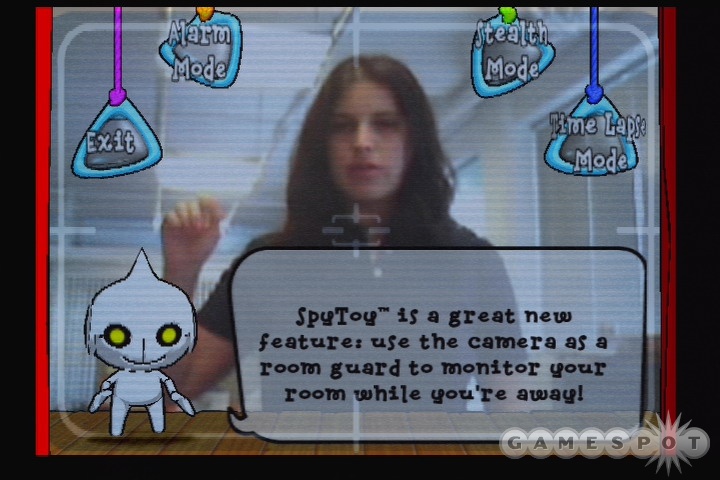EyeToy: Play 2 is a brand-new collection of minigames, messaging, and camera tricks all rolled into one, with an additional feature called SpyToy tacked on. It's not going to win over any new fans for the Eye Toy franchise, since all of the minigames build upon existing EyeToy mechanics, but old fans will be treated to a whole slew of new games that are, for the most part, longer and better than they were before. As always, the strength of EyeToy is in the multiplayer, and Play 2's multiplayer is particularly enjoyable. EyeToy: Play 2's biggest flaws are exceptionally long loading times and the occasional technical hiccup, which slightly devalue this otherwise quite enjoyable game.

Play 2 is the fourth game that has been made for the PlayStation's EyeToy peripheral, a small USB camera that projects an image of a player onto a television set. Players position the camera so that they're centered on the screen, and then use their own bodies in lieu of a controller, twisting, bending, and waving their arms about to impact, clear away, or otherwise manipulate the objects in the game. One of the very basic requirements of Play 2 is that you have to stand in a well-lit room with a fairly neutral background and have the freedom to jump about (although we found that the game worked fairly well in most locations, as long as the lighting was plentiful). A red LED light on the camera will alert you if the area is too dark, but if the light in the room is uneven, then your experience will differ based on how much light the different portions of the screen receive. This is, sadly, one of the Eye Toy's biggest drawbacks, because it impacts the responsiveness that is crucial to so many of the minigames, causing your experience to vary not only between games, but also between portions of the screen within the same game.
Play 2 is divided into two types of interaction: games and extras. The extras menu contains the video messaging feature, which allows you to record videos of varying length to save onto your memory card and play back at another time. Among the extras is also where you'll find SpyToy, the new feature for this game that lets you turn your EyeToy into a verifiable security camera. You can set your EyeToy to monitor a room and to take pictures whenever triggered by motion or sound disturbances. You can alternatively keep a time-lapse photo record of the room that you can play back flipbook-style later. The SpyToy might be useful in nabbing pesky younger siblings who might try sneaking into your room, but otherwise, if you live alone, or if there's no chance of intruders on a daily basis, you probably won't get much use out of it.

The playroom consists of a bunch of toys that showcase some of the things that the EyeToy can do, although nothing in the playroom is explicitly a game. You can fiddle around with visual effects and how your movement and sound impact different mechanisms. Most of what goes on in the playroom is worth checking out briefly, although nothing is really captivating enough to play for more than a few seconds. The two best features in the playroom are the living solar system, which you can explore planet by planet, and the pool table. You can also make a model of your own head, called a Cameo, which you can then proceed to play with and beat up. Unfortunately, the ratio of entertainment you can get from playroom games to the amount of time you have to spend loading them is not in the game's favor. This is a step backward from the original Play, which allowed you to navigate through the playroom much more easily.
The 12 minigames in Play 2 can either be played single-player or with up to four players in the multiplayer game. Most of the game's depth is here, and unlike the original Play, each minigame now has multiple different levels and objectives. In the single-player mode, you'll play through the levels all at once in a story mode-type of progression. Multiplayer lets you pick which subgame of each minigame you and your friends will compete in. Revisiting EyeToy: Play 2 is "Kung2," which is virtually identical to "Kung Foo," the popular ninja game from the first version. There are also 11 games that may or may not remind you of previous minigames, and are almost all significantly longer and more detailed than anything that has been on the Eye Toy before. These games are Air Guitar, Bubble Pop, DIY, Drummin', Goal Attack, Homerun, Knockout, Monkey Bars, Mr. Chef, Secret Agent, and Table Tennis.
Whether you're playing the single-player mode or the multiplayer, much of Eye Toy's entertainment value comes from interacting with other people or making ridiculous faces and gestures in front of them. The multiplayer mode has been refined from Play, and it is easy to navigate through the mode quickly. The players are able to customize individual icons much more easily, as well as keep track of their scores over the entire competition. For this reason, EyeToy: Play 2 is a must-have party game, if you're into that sort of thing.

The presentation of Play 2 is generally better than the previous EyeToy games. The menus are easy to navigate between, although the loading times are burdensome after awhile. Most of the graphics are cute and pleasant to interact with, though all of it is ancillary to the center graphic, which is you. Again, you might have problems with the game if you're not in a very well-lit room, so that should be one of the main criteria you make before opting to play this game. The music is pleasantly themed, and in some modes, like Air Guitar and Drummin', it is central to how you play the game. While playing Drummin', we noticed that the music changes depending on what type of drums you're playing, which is a nice touch.
If you are interested in an Eye Toy but don't yet have one, you should skip buying Play and proceed directly to Play 2, as it's almost universally better than the first game. The mini-games are longer and more detailed, and the multiplayer is smoother and generally more fun. A few technical difficulties bar Play 2 from being a truly great game, but it is otherwise what you would expect from a good sequel to a good game.